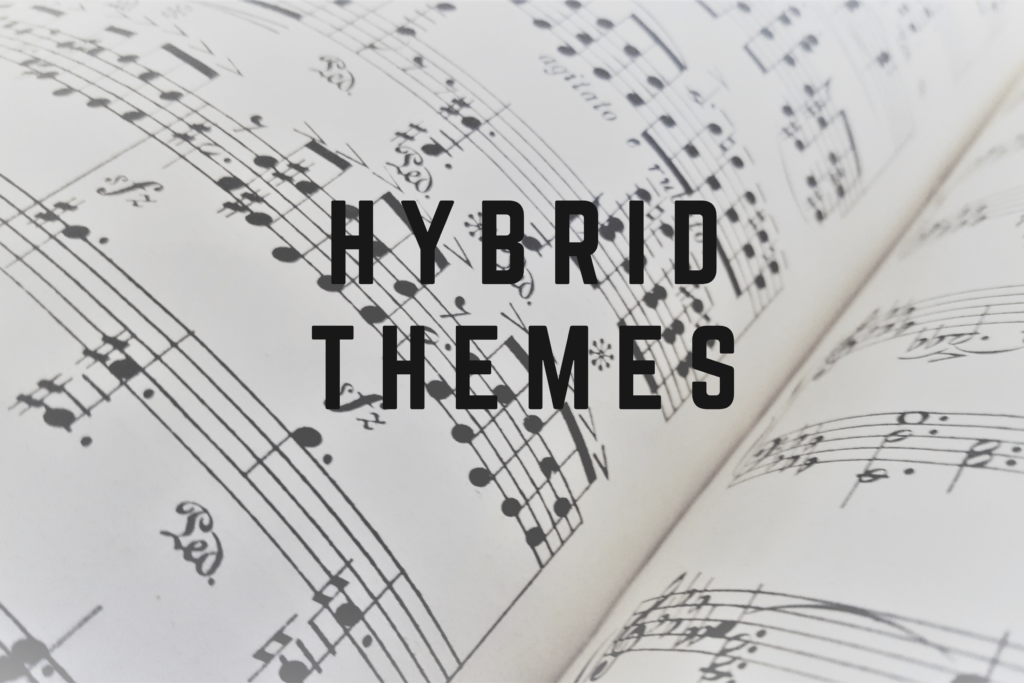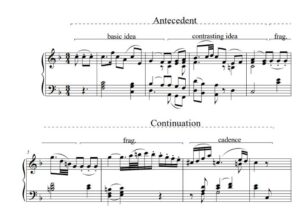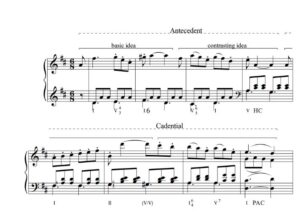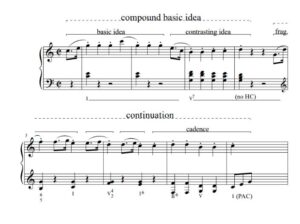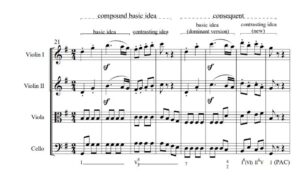Haydn Sonatas, Music Theory Resoucers
Piano Sonatas – Analysis: Hybrid Themes
Piano Sonatas – Analysis: Hybrid Themes
Welcome to the sixth article on William Caplin’s formal theory in this series. Today we will talk about hybrid themes. Throughout the article, we will explain what it is and its structure, and we will analyse various pieces belonging to classicism to see how to apply this analysis tool to works from that period.
In order to understand the meaning of Hybrid themes, we must remember that a theme is, in Caplin´s words,
“A complete formal unit, which includes its particular melodic-motivic content, its accompanimental texture, and its supporting harmonic progressions”
The definition of Hybrid by the Cambridge Dictionary is the following:
“Something that is a combination of two different things, so it has qualities relating to both of them”
Once that we have defined the terms “theme” and “hybrid” we can infer that a hybrid theme is a complete formal unit that resembles in some ways the two fundamental theme types: the period and the sentence.
The four main types of hybrids are:
- Antecedent + continuation
- Antecedent + cadential
- Compound basic idea + continuation
- Compound basic idea + consequent
Next, we will see an example of each type and analyse their main features.
Antecedent + Continuation
Let’s take a look at the first 8 bars of the second movement of Mozart’s Piano Sonata in C major (K. 330).
The theme begins with a 2-m. basic idea followed by a contrasting idea ending with an HC. It is thus a standard antecedent phrase of the type that begins a period. But the second phrase does not bring a return of the basic idea, as we would expect of a consequent. Rather, the phrase begins with new material that fragments the preceding 2-m. ideas into 1-m. units and modulates to the dominant region. In other words, the phrase projects the typical features of a continuation, just like the second half of a sentence.
This theme, in other words, begins like a period but ends like a sentence: it is a hybrid of the two theme types. Here we see one type of hybrid, which we can identify by its two constituent phrase functions: antecedent + continuation.
Antecedent + Cadential
As an example to explain this type of hybrid theme, we will analyse an excerpt of the third movement of Beethoven’s Violin Sonata in D (Op. 12). For this example, we have selected the first 8 bars of the work, where the piano begins with an introduction while the violin waits to begin playing the main melody.
This type of hybrid theme begins with an antecedent phrase. The second phrase, however, displays minimal characteristics of continuation function (such as fragmentation, harmonic acceleration, and sequence). Since the phrase is supported entirely by an expanded cadential progression, it exclusively projects a cadential function.
It is interesting to notice that this same excerpt has been used in different music theory manuals. In the book titled “Tonal Harmony”, Stefan Kostka states that this passage is a contrasting period, since, according to his point of view, a period is a group of 4 measures that ends in a weak cadence, followed by another group of 4 bars that ends in a stronger cadence. Kostka qualifies this passage as a contrasting period because he analyses the beginnings of each phrase and, according to his point of view, a period in which the phrase beginnings are not similar is called a contrasting period.
These dissimilar perspectives among different authors invite us to reflect that music theory is not objective, but that the analysis will necessarily be the product of an analyst. In this case, we believe that William Caplin’s analysis is more exhaustive and more useful for our purpose, which is to understand the music of the second half of the 18th century from a morphological aspect.
Compound Basic Idea + Continuation
In this hybrid type, the opening 4-m. phrase is neither an antecedent nor a presentation, but rather a combination of the two, a new phrase function that bears the rather complicated term compound basic idea. The second phrase is a continuation. A compound basic idea consists of a 2-m. basic idea followed by a 2-m. contrasting idea, but it does not close with a cadence. The underlying harmonic support for the entire phrase is tonic prolongational.
In order to clarify what we have mentioned, we will proceed to analyse the beginning of the first movement of the Piano Sonata in C (H. 35) by Haydn.
At first glance, the opening phrase might seem to be a regular antecedent, since the basic idea is followed by a contrasting idea ending with a dominant triad in m. 4. But because that dominant first appears in m. 3 to support the entire contrasting idea, we cannot identify a specific progression to create an HC in the final measure of the phrase. Indeed, the phrase contains a single I – V7 tonic prolongation. Because of the lack of cadence, the opening phrase must be defined as a compound basic idea. The following phrase is a typical continuation featuring fragmentation and harmonic acceleration and closing with a PAC.
Compound Basic Idea + Consequent
This hybrid begins with a compound basic idea. Measures 5 and 6 of the theme, however, bring back the opening basic idea in the manner of a consequent phrase.
Let’s take a look at an excerpt from the fourth movement of Beethoven’s String Quartet in G, Op. 18, No. 2.
The first phrase is a compound basic idea; the absence of any harmonic motion into m. 24 prohibits us from recognizing any cadence there. The second phrase brings back the initial basic idea (now supported by dominant harmony), and the subsequent contrasting idea brings an emphatic PAC to close the theme.
Throughout this series of articles, we have learned the fundamental theme types: The period, the sentence, and hybrid themes. While these were widely used by composers of the common practice period, that does not mean that we can classify absolutely all themes into these three categories. Compositional practice is complex, and there will be times when these three categories are not enough to label a theme. The usefulness of studying these theme types lies in the fact that they open a door for us to understand even better the works of the great composers of the common practice period.
SUMMARY BY JUAN REZZUTO Piano Sonatas – Analysis: Hybrid Themes:
OVERVIEW of Piano Sonatas – Analysis: Hybrid Themes
Music from the proper classical period can seem simple from the surface but there is a lot of complexity hidden in its formal depths.
The hybrids are built up combining 5 of the functions used in the period and the sentence:
Antecedent, continuation, cadential, compound basic idea and consequent.
Hybrid types
The four possible continuations are:
- Antecedent + Continuation
- Antecedent + Cadential
- Compound basic idea + Continuation
- Compound basic idea + Consequent
Compound Basic Idea
The compound basic idea consists of 2-m. basic idea followed by a 2-m. contrasting idea but it does not close with a cadence; instead the underlying harmonic support is tonic prolongational.
Melodically and motivically it evokes and antecedent while harmonically it is clearly similar to a sentence.
It is an hybrid between antecedent and presentation functions
Antecedent + Continuation
Unlike a sentence this hybrid type always closes with a PAC complementing the waker cadence of its antecedent.
Its continuation usually doesn’t exhibit any harmonic acceleration as the contrasting idea already started this process. On the contrary it tends to exhibit strong signs of motivic fragmentation.
It can modulate to another key
Antecedent + Cadential
The second phrase is an ECP or “continuation=>cadential”
It very rarely modulates.
Compound Basic Idea + Continuation
It can end with any cadential type, including the HC.
The same as the sentence the continuation can end being understood as cadential (“continuation=>cadential”). It will still show continuation characteristics. If on the contrary it doesn’t show any continuation characteristics whatsoever then it should be labelled cadential.
It can modulate to another key
Compound Basic Idea + Consequent
It lacks a HC at the end of the first phrase. The return of the basic idea in the consequent is supported by a different harmony (much more often than in the period). This continuation can exhibit characteristics of harmonic acceleration.
The same as the period this hybrid can modulate.
Hybrid Themes in relation to Sentence and Period

CBI & Continuation (or cadential, or continuation=>cadential): The same as the sentence but includes a contrasting Idea in the CBI
Antecedent & Continuation: Equally similar to the sentence and the period.
Antecedent & Cadential: It can be considered more periodical as continuational features are weaker.
CBI & Consequent: It is almost the same as a period but it lacks a weak cadence.
The basic idea and its appearances
Both in the sentence and in the period the basic idea appears twice the same as in the CBI + consequent.
In the remaining three hybrid types the basic idea appears only once. The single appearance of the basic idea helps the modulation to a neighbouring key -with the exception of the “antecedent+cadential”-
Piano Sonatas – Analysis: Hybrid Themes
#compositionlondon #composition #JuanRezzuto #Haydnproject #HaydnProject #Caplin

